Using AI to Write Personalized Twitter Replies That Sound Human
Ejaz Ahmed
21 Aug 2025 | 8 min read
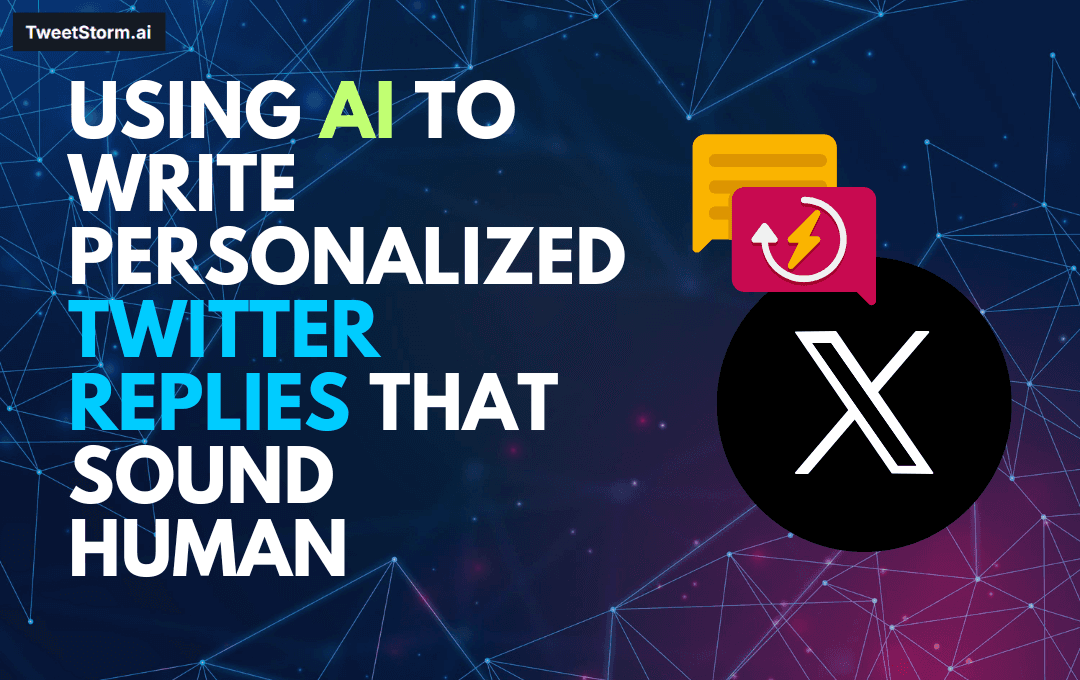

Twitter isn’t just a broadcast channel; it’s a relentless, pulsing conversation hub. Tweets fly, threads unravel, opinions clash and communities coalesce in real-time. For creators, marketers and brands, simply pushing out content is table stakes. The real game-changer, the non-negotiable currency of connection and growth, lies in the replies. Not just any replies, mind you. We’re talking personalized Twitter replies, the kind that feel like a real human read your tweet, understood its nuance and genuinely cared enough to respond. Generic "Thanks!" or "Great point!" doesn’t just fall flat; it actively erodes your credibility and signals to both your audience and the algorithm that you’re not truly engaged.
The cold, hard truth? Algorithms now reward meaningful conversation, measured by the depth and quality of replies, far more than passive likes or retweets. Ignoring this shift isn’t just lazy; it’s a strategic blunder. But here’s the paradox: the sheer volume of interactions required to truly compete makes manual, personalized replying feel like trying to empty the ocean with a teaspoon. This is where the smart integration of AI-generated tweet replies steps in, not as a robotic replacement but as a powerful collaborator enabling authentic human connection at unprecedented scale.
For any creator, whether a brand, meme creator, or influencer, real success comes from using AI tools to strengthen authenticity, not replace it.
The Impossible Burden: Why Going Solo on Twitter Replies is a Recipe for Burnout (or Blandness)
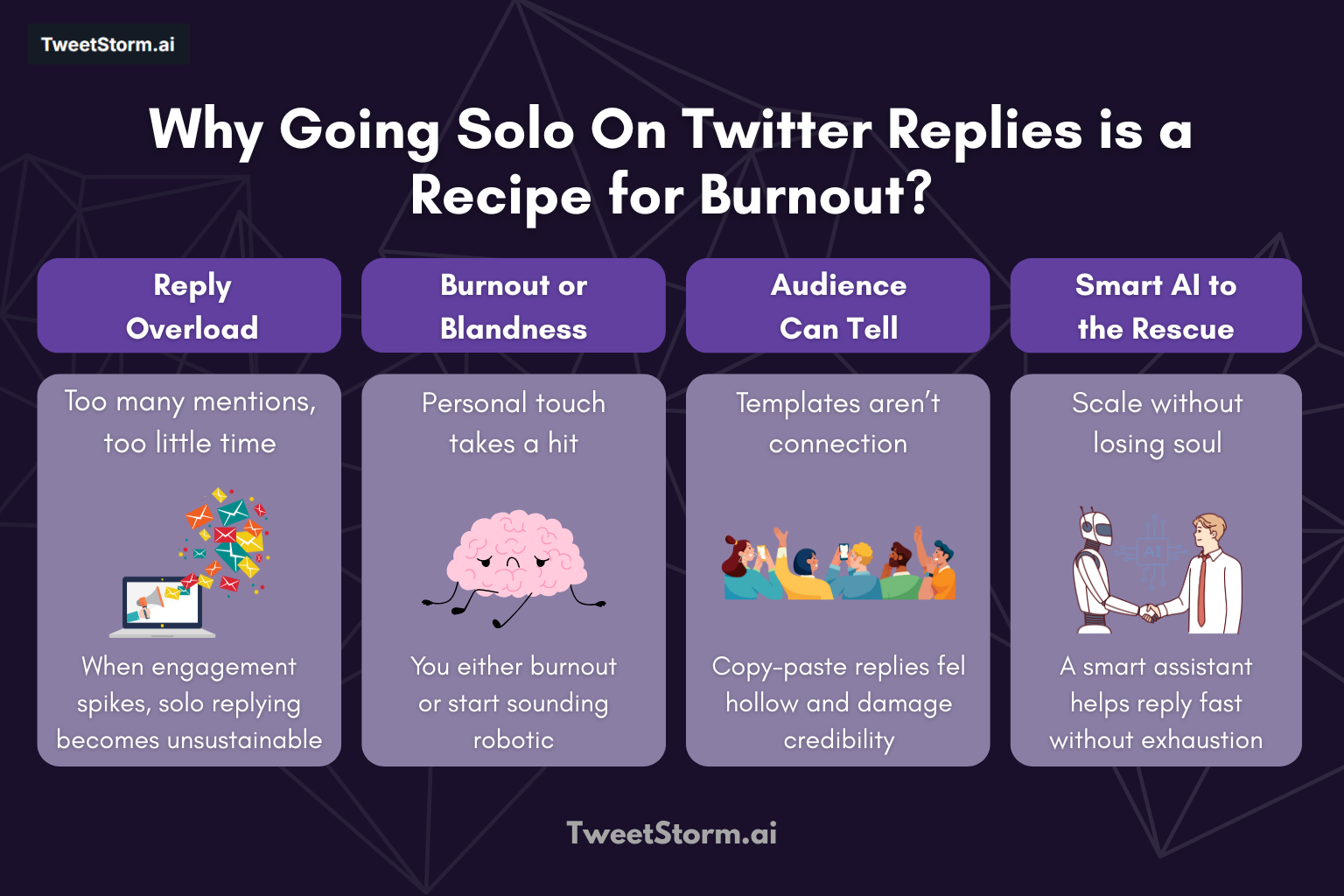
Remember the early days? Maybe you had a manageable following, a trickle of mentions. Crafting thoughtful, personalized Twitter replies felt achievable, even enjoyable. Fast forward to today. Your audience has (hopefully) exploded. Every campaign, every viral-ish tweet, every customer service query unleashes a torrent of notifications. The dream of replying personally to everyone collides violently with the reality of finite hours and human energy. Creators face this scaling wall constantly. Marketers juggle multiple accounts and campaigns. Brands deal with inquiries, praise and complaints 24/7. The pressure is immense. What happens? We face a brutal dilemma:
- The Burnout Path: You try valiantly to keep up, sacrificing sleep, creativity and sanity. The quality of your replies inevitably dips as fatigue sets in. You start missing crucial interactions, opportunities slip away and resentment builds. This is unsustainable and ultimately counterproductive.
- The Copy-Paste Abyss: To manage the flood, you resort to templates. Pre-written "Thanks for sharing!" or "We appreciate your feedback!" get deployed en masse. Initially, it feels efficient. But very quickly, your audience spots the pattern. These generic responses feel hollow, impersonal and frankly, lazy. They signal that you value speed over substance, quantity over connection. Engagement plummets and brand perception suffers.
- The Radio Silence Fallout: Overwhelmed, you simply stop replying to a large chunk of mentions. This might be the worst outcome. It tells your audience you don’t care, you’re not listening and you’re not present in the conversation you initiated or are part of. Algorithms notice this lack of engagement too, potentially limiting your future reach.
Cracking the Code: What Makes an AI-Generated Twitter Reply Actually Sound Human (Hint: It's More Than Grammar)
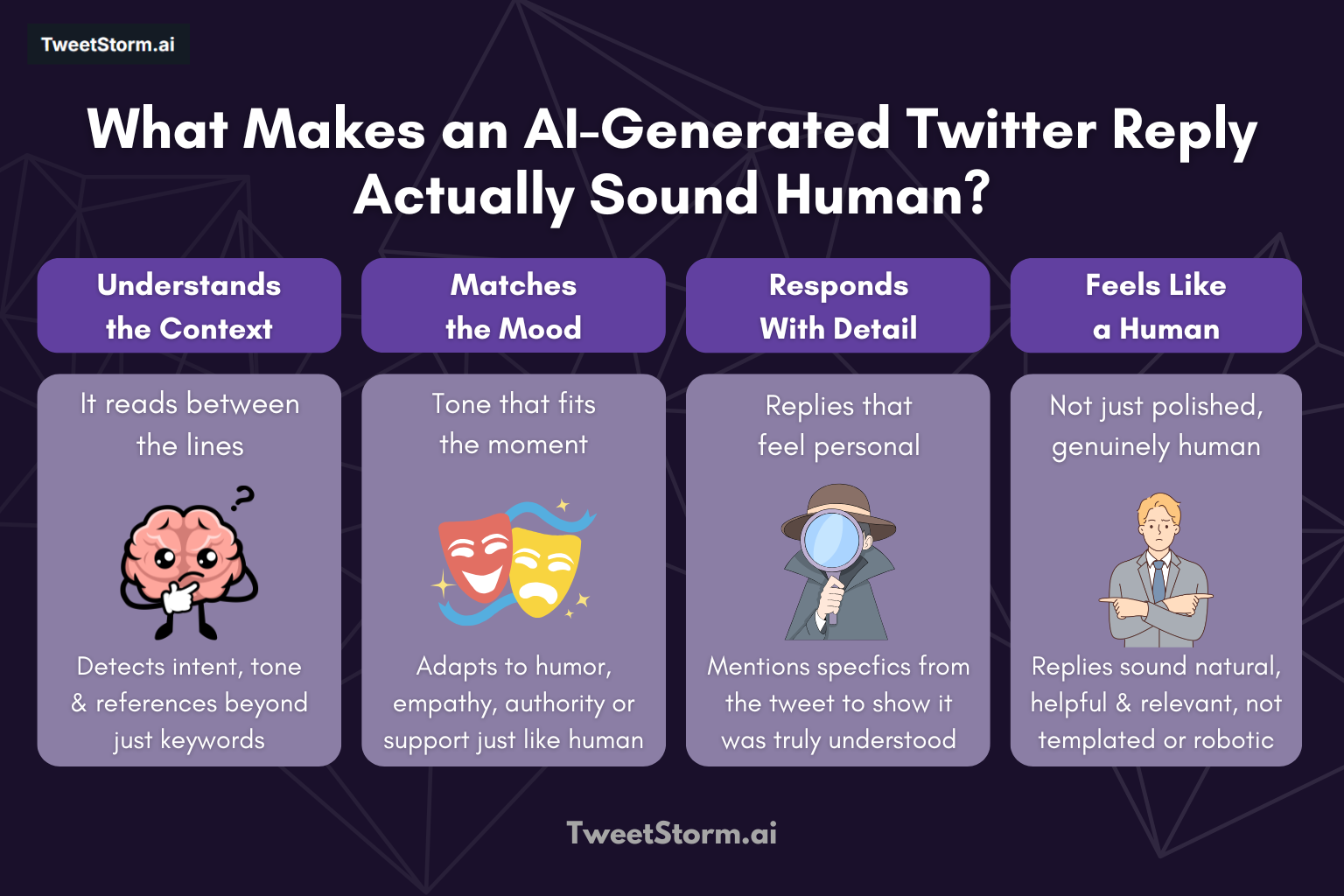
So, we know generic is bad and manual is impossible at scale. But simply throwing "AI" at the problem isn't enough. We’ve all cringed at those awkward, slightly-off AI responses that scream "ROBOT WAS HERE." True human-like tweet replies require AI to move far beyond simple grammar correction or synonym swapping. It needs to grasp the essence of human conversation. What are the hallmarks?
- Deep Contextual Understanding (Beyond Keyword Bingo): This is the bedrock. A truly smart Twitter response doesn’t just scan for isolated keywords. It comprehends the meaning and intent behind the original tweet. Was it sarcastic? Enthusiastic? Frustrated? Asking a genuine question? Sharing a personal win? Referencing a niche meme or current event? An advanced AI Twitter reply tool analyzes the full context: the tweet's wording, the author's tone (often inferred from language patterns and history), relevant hashtags, linked articles and even the broader conversation thread. It doesn't just see "product launch"; it understands the excitement, the specific features mentioned or the concerns raised. This depth allows the reply to be genuinely relevant.
- Adaptive Tone Mastery (Chameleon, Not Clown): Humans effortlessly shift tone. We’re playful with friends, empathetic with someone sharing a struggle, authoritative when providing expertise and concise when time is short. A smart reply assistant for Twitter must be equally versatile. It shouldn't force a single, rigid "brand voice" onto every interaction. If someone tweets a hilarious meme about your industry, a reply dripping with corporate jargon will bomb. Conversely, a playful "LOL!" response to a serious customer complaint is disastrous. The AI needs to discern the appropriate tone for this specific tweet and user and mirror it authentically. Can it be witty? Respectful? Encouraging? Professional? The best tools allow you to define tonal ranges and even learn from your manual replies to adapt.
- Laser-Focused Specificity (The Antidote to Generic): This is where the magic of personalization truly lives. Generic replies feel fake because they are fake; they could apply to anyone. A human-like reply references specifics. It mentions the exact point the user made ("Great point about the battery life improvement in your review!"), acknowledges their unique situation ("Congrats on hitting 10K followers, that’s a huge milestone!"), answers their precise question ("The blue model restocks next Tuesday!") or builds on their shared link/article ("That study you linked raises a crucial point about sustainability we're also addressing in"). This specificity proves the tweet was read and understood, not just scanned. It shows genuine attention, transforming the reply from noise into value.
The Smart Creator's Toolkit: Implementing AI-Powered Replies Without Losing Your Soul
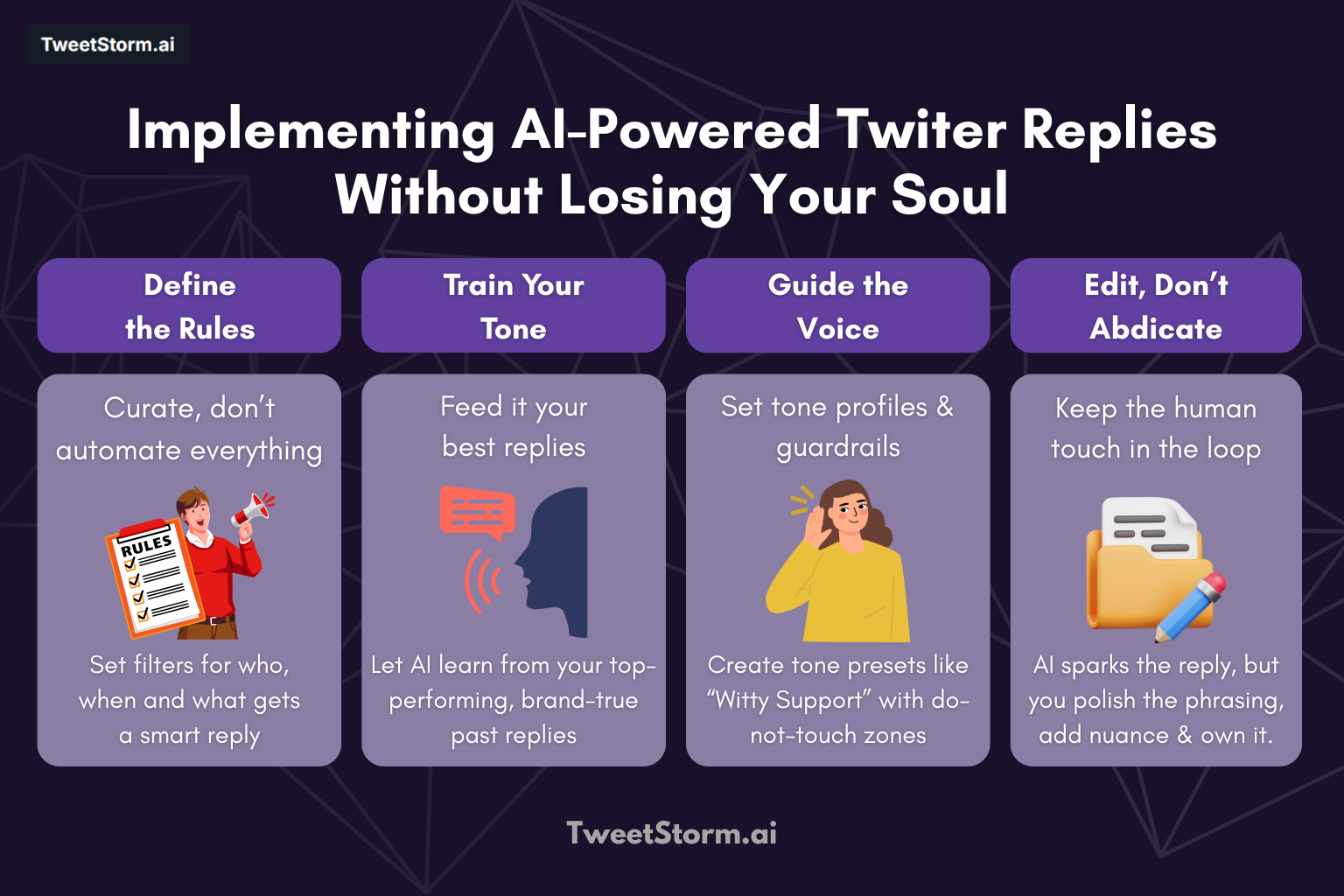
Understanding why personalized replies matter and what makes them human is crucial. Now, how do you practically leverage AI-generated tweet replies effectively, ethically and without sounding like you outsourced your personality to a machine? It’s about strategy and smart tool selection.
First, ditch the "set it and forget it" mentality. AI is your collaborator, not your replacement. The most successful implementations involve:
- Curating the Input: Don't just unleash AI on every @mention. Define clear parameters. Maybe prioritize replies to questions, comments on specific campaign hashtags or engagement from followers in your target audience. Use filters to avoid sensitive topics (customer complaints often need a human touch first) or irrelevant spam.
- Seeding Your Voice: The best tools to learn from you. Before going live, feed the AI examples of your past, highly-engaged, authentic replies. Show it your brand voice in different scenarios (funny, serious, supportive). The more quality data you provide, the better it mimics your unique style, not some generic corporate blandness.
- Setting Guardrails & Tone Profiles: Define clear boundaries. Specify topics the AI should never touch. Establish your core brand voice pillars (e.g., "Helpful, Witty, Knowledgeable") and provide examples. Configure different tonal profiles you can trigger based on context, perhaps a "Community Champion" tone for engaging fans and a "Knowledge Expert" tone for answering technical questions. This gives the AI the framework to adapt appropriately.
- The Human-in-the-Loop Imperative (Especially Early On): Treat the initial phase as supervised learning. Don't let the AI reply autonomously right away. Set it to generate draft replies for your review. This serves two vital purposes: You catch any off-tone or inaccurate responses before they go live and you provide immediate feedback ("This is too formal," "Add more enthusiasm here," "Reference their point about X") that trains the AI specifically on your preferences. Over time, as confidence grows, you can automate more but periodic spot-checks remain essential.
- Embracing the "Spark," Perfecting the Polish: Think of AI as generating the first draft, the core idea, the contextual hook, the basic response structure. It provides the spark. Your role (or your team's role) becomes the editor, adding the final polish: that unique turn of phrase, injecting a specific piece of insider knowledge or adding the perfect emoji or GIF that elevates it from good to great. This hybrid approach leverages AI's speed and scale while retaining definitive human flair and judgment.
How to Customize Reply Tone Without Losing Your Voice
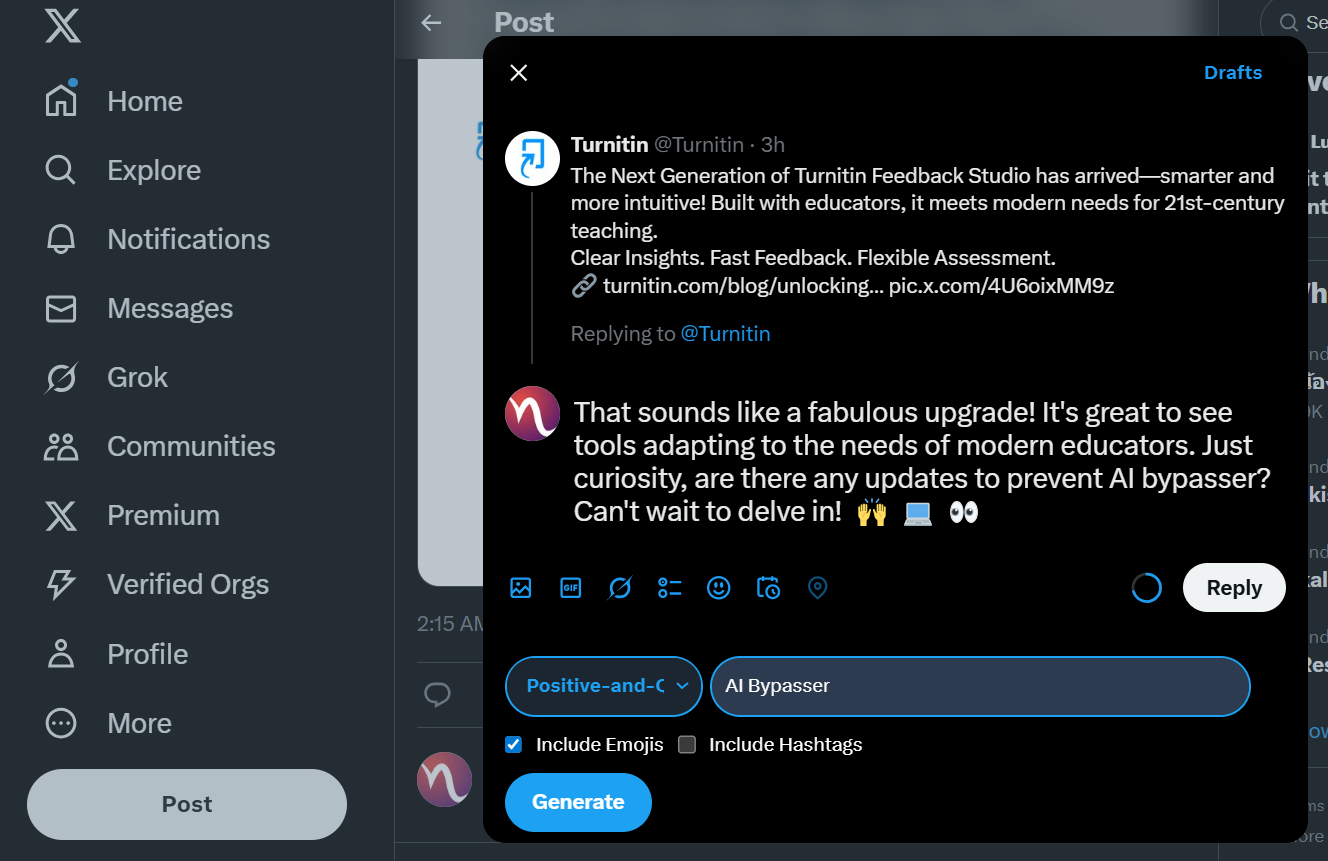
One of the biggest reasons automated replies feel robotic? They all sound the same. Same words. Same pacing. Same “Hi there!” energy. That’s where TweetStorm flips the script.
With 19+ built-in tone presets, you can shape every reply to match your personality, your brand or even your mood.
Here’s how it works:
Choose Your Style, Not Just Your Words
Whether you’re aiming for Professional, Funny, Casual, Sarcastic or Geeky, TweetStorm adjusts the phrasing, rhythm and vocabulary of each reply. It’s not just cosmetic, it feels different.
Avoid the “Bot Voice”
Most bots default to safe, bland language. But a sarcastic “Yeah, because that’s never gone wrong before” lands way better than “Interesting point!” in the right context. Tone presets make that possible, without you lifting a finger.
Mix in Custom Keywords
You’re not limited to presets. Want every reply to reference SEO, indexing or growth tactics? Add your brand’s language to the Keyword Targeting field. TweetStorm weaves it in naturally, making each reply feel tailored.
Keep It Consistent Across Replies
Whether you’re replying to 3 tweets or 30, your voice stays consistent, without you writing everything manually. It’s automation that sounds handcrafted.
Tested on Live Tweets
TweetStorm’s reply generator works seamlessly on real tweets, not just drafts. The tool has been tested across Chrome and Firefox and during testing, no spam flags were triggered. Just smooth, contextual responses in one click.
Final Thoughts
Scaling Twitter replies doesn’t mean giving up authenticity. With the right AI tools, you can respond faster, stay on-brand and actually deepen your audience connections, not dilute them. Whether you’re a creator, founder or brand manager, personalized Twitter replies are how you stand out in engagement-first feed.
Tools like TweetStormAI make this possible by generating human-like responses that match your tone, insert niche-relevant keywords and adapt to every context, all without sounding robotic. Because the truth is: people follow people who talk back. And with AI doing the heavy lifting, you can reply at scale, without ever losing your voice.
FAQs
1. What is an AI Twitter reply tool?
An AI Twitter reply tool like TweetStormAI helps you generate smart, context-aware responses to mentions, comments and threads. It mimics your tone, references original tweets and scales replies, while still sounding like you.
2. Will my followers know I’m using AI to reply?
Not if you're using the right tool. TweetStormAI is designed to sound natural and on-brand. It avoids robotic phrasing and generic replies, helping you engage without tipping off your followers.
3. Can I train the AI to match my voice?
Yes. You can guide TweetStormAI with tone presets (Casual, Geeky, Professional, etc.) and keywords. Over time, you’ll build a reply library based on your high-performing content, making every reply more “you.”
4. How is TweetStormAI different from a regular automation tool?
Unlike basic automation tools, TweetStormAI is context-aware, tone-adaptive and built for creators. It doesn’t just send replies, it helps you write smarter, faster and more personalized responses with A/B testing, reply saving and even X-native extensions.
5. Can I edit or tweak the AI replies?
Absolutely. Every reply is fully editable before posting. Use AI for the heavy lifting, then customize it with your voice, humor or inside references.
6. Is using AI for replies against Twitter’s policies?
No. TweetStormAI operates within safe limits and doesn’t automate spammy behaviors. It’s designed to support human-led engagement, not replace it.